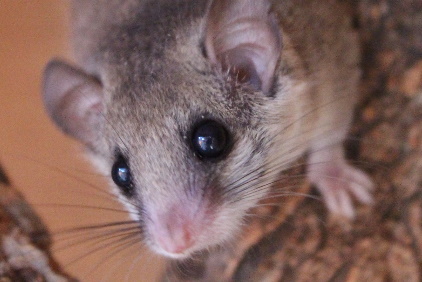African Pygmy Dormice Environment
African Pygmy Dormice are incredibly active, so it is important to give them an environment with plenty of branches and climbing material. A large arboreal vivarium is ideal for dormice as height is much more important than length.
A breeding pair need more space than a same-sex pair and as they are colony animals, you should try and a minimum of a pair. Please only get a breeding pair or trio if you are able to swop animals with another breeder, to prevent inbreeding.
A 60 x 45 x 45cm Exo-Terra can work well for a breeding pair if offspring are to be homed, otherwise a 3 foot aboreal vivarium makes a good minimum. The dormice vivarium pictured on the right measures 80cm width, 100cm height and 48cm depth and can happily house around 6-10 African Pygmy Dormice. African Pygmy Dormice should always be kept with company where possible so a pair should have a minimum of 60 x 45 x 45cm. Vivexotic do a good range of arboreal vivariums for a reasonable price, that are often available second-hand. You could order a custom vivarium for a good price or could build your own for much cheaper providing you have good DIY skills.
Temperature
Given that these are an African species, they need a temperature of at least 21°C in your Dormouse vivarium to avoid them going into a state of torpor. You need a temperature gauge on the side of your vivarium so you can monitor this.
Nesting
A Dormouse setup will need as many nest boxes as animals in your habitat. Blue tit nesting boxes with small entrances holes are favoured as well as suspended hollowed out coconuts are ideal. However, do bear in mind that there will be occasions when you may need access to these nests in order to clean them.
Filling your vivarium
Branches taken straight from woods and trimmed to size must be dry, good quality woods for your Dormouse setup. Before use place them in the oven for around 20 minutes first to remove any parasites and check you are using wood that has not been collected near a roadside and that is safe for rodent use.
A small solid-surface rodent wheel can be handy, and sisal rope is useful for climbing and hiding small sunflower seeds or peanuts inside the twists. Do not chose nylon or other plastic ropes.
Climbing nets such designed for ferrets are loved, also some wooden parrots toys are useful. Just consider in terms of height, more than breadth and remember that will need cover to hide from you and from light.
Some reptile-friendly artificial branches and leaves can be draped across your vivarium, and twisted into the sisal rope. Exo-Terra backgrounds are an attractive feature for a Dormouse vivarium however many Dormice will nibble on these and may try to nest behind them.
See our article on How to Furnish a Vivarium for an Exotic Rodent for more details on setting up your dormouse vivarium and links to a DIY guide for building your own vivarium.

